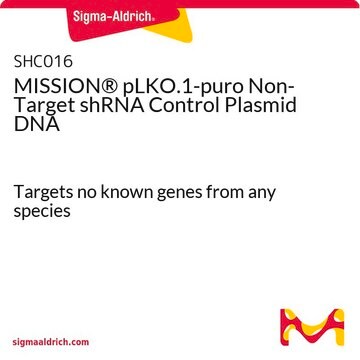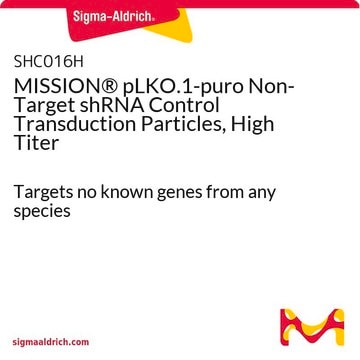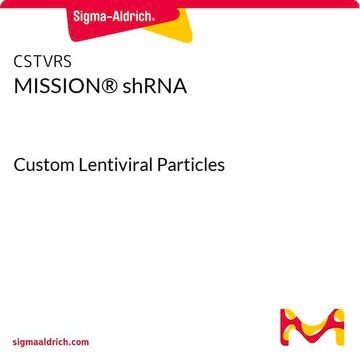暫時無法取得訂價和供貨情況
推薦產品
一般說明
The MISSION® pLKO.1-puro Non-Target shRNA Control Transduction Particles contain an shRNA insert that does not target any known genes from any species, making it useful as a negative control in experiments using the MISSION® shRNA library clones.[1][2] This allows one to examine the effect of transduction of a short-hairpin on gene expression and interpret the knockdown effect seen with shRNA clones. Ampicillin and puromycin antibiotic resistance genes provide selection in bacterial or mammalian cells respectively. In addition, self-inactivating replication incompetent viral particles can be produced in packaging cells (HEK293T) by co-transfection with compatible packaging plasmids. The Non-Target shRNA Control Transduction Particles are provided as 200 μL at 1 x 106 TU/mL via p24 assay.
当使用MISSION® TRC shRNA克隆进行实验时,选择适当对照品是您的实验设计的关键要素,以便准确解释敲低结果。 MISSION对照转导颗粒是监测转导效率的关键阳性对照。
想要查看更多应用数据、实验方案和载体图谱,请访问 sigma.com/shrna。
想要查看更多应用数据、实验方案和载体图谱,请访问 sigma.com/shrna。
應用
MISSION® pLKO.1-puro Non-Target shRNA Control Transduction Particles have been used to generate 3T3-L1 (pre-adipocytes) control cell lines.[3]
分析報告
To see more application data, protocols, vector maps visit sigma.com/shrna.
法律資訊
MISSION is a registered trademark of Merck KGaA, Darmstadt, Germany
未找到適合的產品?
試用我們的產品選擇工具.
推薦
產品號碼
描述
訂價
儲存類別代碼
12 - Non Combustible Liquids
水污染物質分類(WGK)
WGK 3
閃點(°F)
Not applicable
閃點(°C)
Not applicable
從最近期的版本中選擇一個:
客戶也查看了
SIRT6 Depletion Suppresses Tumor Growth by Promoting Cellular Senescence Induced by DNA Damage in HCC.
Lee N
PLoS ONE, 11(11), e0165835-e0165835 (2016)
Sekar Natesampillai et al.
Journal of immunology (Baltimore, Md. : 1950), 203(3), 718-724 (2019-06-14)
CD4 T cells from HIV-1 infected patients die at excessive rates compared to those from uninfected patients, causing immunodeficiency. We previously identified a dominant negative ligand that antagonizes the TRAIL-dependent pathway of cell death, which we called TRAILshort. Because the
Caitlin E Jones et al.
PloS one, 16(2), e0245653-e0245653 (2021-02-04)
Collagen deposition contributes to both high mammographic density and breast cancer progression. Low stromal PTEN expression has been observed in as many as half of breast tumors and is associated with increases in collagen deposition, however the mechanism connecting PTEN
Namgyu Lee et al.
PloS one, 11(11), e0165835-e0165835 (2016-11-09)
The role of Sirtuin 6 (SIRT6) as a tumor suppressor or oncogene in liver cancer remains controversial. Thus, we identified the specific role of SIRT6 in the progression of hepatocellular carcinoma (HCC). SIRT6 expression was significantly higher in HCC cell
Hedgehog associated to microparticles inhibits adipocyte differentiation via a non-canonical pathway.
Fleury A
Scientific Reports, 6 (2016)
Active Filters
我們的科學家團隊在所有研究領域都有豐富的經驗,包括生命科學、材料科學、化學合成、色譜、分析等.
聯絡技術服務











